4 Best Examples of Testimonials in Advertising

Testimonial advertising is worth your while, because we all tend to ask friend and colleagues for recommendations before buying anything. In addition, 98% read online reviews for local businesses before visiting or buying.
Let's go over different ways you can use testimonials in advertising to boost sales.
Why Testimonial Advertising Works?
Your existing satisfied customers and customer testimonials from them are the biggest sources of motivation for potential customers. They are excellent to be used in digital advertising, social media ads, and wherever imaginable!
When your past customers share their online reviews of how your product or business has helped them, it simultaneously:
- inspires new potential customers
- boosts brand credibility, and
- increases traffic to your sales pages
If you don't have a testimonial advertising strategy yet, this is your sign to create one!
Avoid These Common Mistakes in Testimonial Advertising
Testimonial ads require some attention to make them as effective as possible.
You should avoid common pitfalls, such as having a testimonial ad that seems too good to be true, using outdated testimonials, or settling for low-quality testimonials.
Ensure the Authenticity of the Testimonial
BrightLocal has compiled reasons that make any consumers suspicious of the authenticity of the reviews they see.
The top 3 reasons include:
- Over-the-top in praise
- All reviews are alike
- Reviewer is anonymous
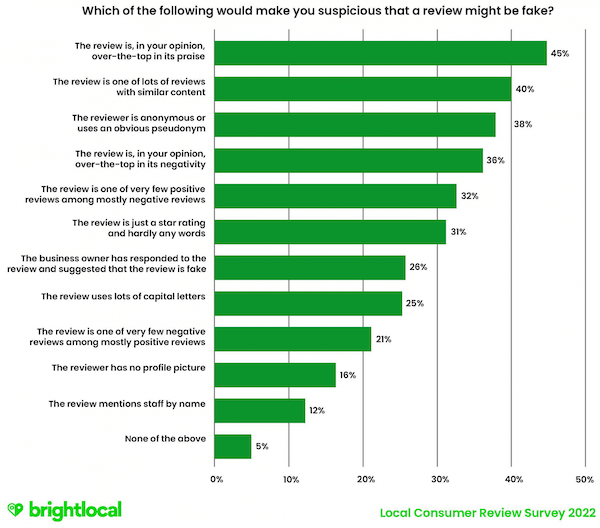
This goes to show that when you're choosing which testimonials to include in your ads, you should make sure that they represent your brand in the best possible way.
The worst possible scenario would be that people deem you as being too suspicious and too untrustworthy.
Use Fresh Testimonials
... Or as fresh as you can. We all know that it's unlikely to keep getting great, ad-ready testimonials regularly.
But you can definitely help the process by asking for testimonials diligently, incentivizing them, inspiring customers to write longer testimonials, and timing the request well.
Next, remember to update the new testimonials in your marketing materials from time to time.
Take Care of Overall Online Reputation
If you use customer testimonials in your advertisements, but you don't have any reviews and testimonials anywhere else, it is easy to question the integrity of your ads.
Thus, it's important to pay attention to overall reputation. If people go looking for experiences about your company, they should come across positive Google reviews, perhaps Yelp reviews, and reviews on any review sites that are relevant to your industry.
Ask all your customers for feedback and reviews to keep new comments coming in and build a good online reputation. Respond to all public reviews, and take part in discussions online.
4 Best Examples of Testimonial Types in Advertising
Few growth tools are as effective as this one when it comes to generating happy customers. Client testimonials, be it video testimonials, influencer testimonials, or quote testimonials, is a game-changer.
There are several examples of customer testimonials in advertising and they're a powerful tool to boost conversion rates, they go well with a sales pitch, and are a great way to social proof your own website (blog testimonials, more professional videos, generating marketing materials, etc.) so more business owners try to acquire more positive feedback through this.
You can use your own customer testimonials in advertising campaigns in different ways to make your brand trustworthy but also add them to a testimonials page.
Do you want to know exactly
- How to make testimonial requests,
- What to do with testimonials
- What are the major customer testimonial examples
- What is testimonial propaganda and
- How to get more customer testimonials to attract new customers?
Let’s find out how a simple customer testimonial can change your business.
1. Video Testimonial
The best example of testimonials in advertising and marketing is none other than video testimonials. Video testimonials work best because they can’t be faked.
A text testimonial can lack context and seem unrelatable, but when someone sees a video of an existing customer sharing their experience, it can’t be ignored. This is exactly what the doctor ordered!
Video Testimonials Work Because of the Nature of the Medium
Video content is highly engaging. An average user spends 88% more time on a website with video as compared to a website without video.
Videos aren’t just engaging but people who watch a video are more likely to buy. A study found that 8 out of 10 people have purchased an app after watching a video of it. It is a direct representation of a customer's experience with your brand!

The best part: Videos give the best ROI according to 52% of the marketing professionals. In other words, a video testimonial is most likely to work and give you a decent return on investment.
Video testimonial advertising examples can be hard to find, but here's are two different examples from Monidor.
First up, they've used Trustmary's video testimonial collection feature to get this remote video testimonial. They posted this one on their Facebook page:

Furthermore, they've opted to create a high-quality testimonial video from one of their customers as well. They've posted this onto their references page.

Here is an example from HubSpot that has created a dedicated testimonial page:
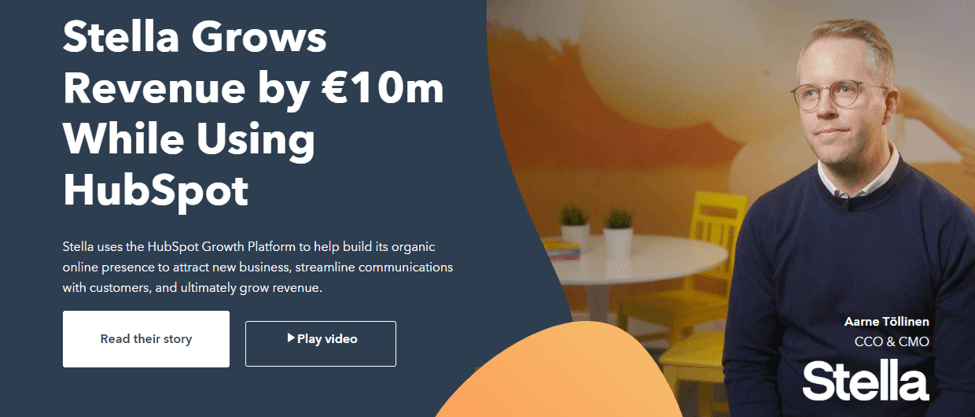
Video testimonials can be used on the website, landing pages, as social testimonials, and of course YouTube channels. The video, however, needs to be high-quality.
It needs to be professional with immaculate quality, sound, and direction to be worthy of your testimonial page. If you're wondering how to make video testimonials, here are top 5 things to consider.
If you can't create a good video, audio testimonials will do the trick and help you get customers.
However, all testimonials need to be presented properly. Otherwise the customer's story doesn't hold as much weight and they become inconsequential as a growth tool.
2. Text Testimonials
Text or quote testimonials are the most common examples of testimonials in advertising. These are easier to acquire and are extremely cost-effective.
Quote testimonials can be acquired easily via email and they can quickly be added to your testimonial pages.
Collecting them is effortless compared to creating a high-end video testimonial that need a lot of work, effort and money.
Using quote testimonials in advertising is an effective approach to improving CTR and conversions. People tend to trust these testimonials more than ads, especially if they are peer testimonials.
Text Customer Testimonials Are Easy to Acquire
Having real customers telling their experiences with you work waaaaay better than anything else. Here's a great example how Windward Business Management Software has added written customer testimonials to their front page.
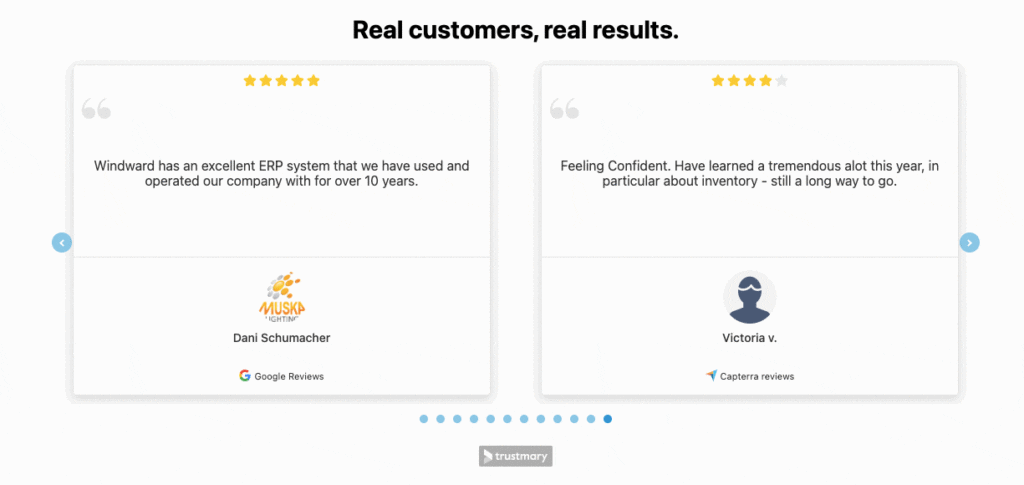
By using Trustmary, they've been able to import reviews from Capterra and Google and to display them directly onto their site.
Here is an example of how Infolinks is using a quote testimonial in its Facebook ad to drive clicks:

You can use these text testimonials on your website too. Here is an example of how SproutSocial is using quote testimonials on its homepage:

The quotation testimonials can be used in all types of forms and across multiple channels. The best approach is to use them everywhere so that prospective customers find testimonials on all the touchpoints.
The quote testimonial should be accompanied by a customer photo, designation, and other details (e.g. link to a website or a social media account).
This makes these testimonials authentic and trustworthy. A mere text testimonial with no photo or further details seems fake. Try to create a catchy subject line for your testimonial request email and encourage customers to fill in the necessary information to make the testimonial credible.
If you are spending resources to acquire a customer testimonial, go the extra mile and ask for their photos and personal details so anyone can verify the authenticity of the customer feedback.
3. Influencer Testimonials
These are the most popular examples of testimonials in advertising today. Influencers, especially micro-influencers, have transformed the marketing industry.
They're everywhere from social networks to podcasts to TV to being a guest interviewee in a blog post here and there.
And rightly so…
The Influencer Marketing Sphere Keeps Growing
Influencer marketing is expected to be a $10 billion industry by 2020. Statistics show that 70% of teens trust influencers more than celebrities and 49% of consumers depend on influencer recommendations for buying a product.
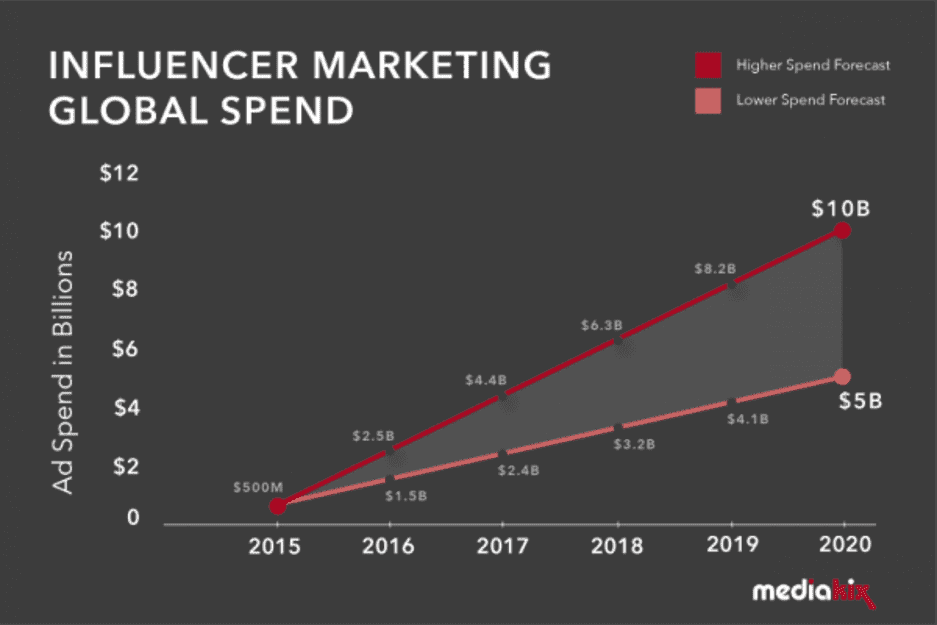
A testimonial from an influencer is more effective than an influencer merely talking about your product or brand. Boxed Water used a customer testimonial on Instagram for awareness and generating sales:
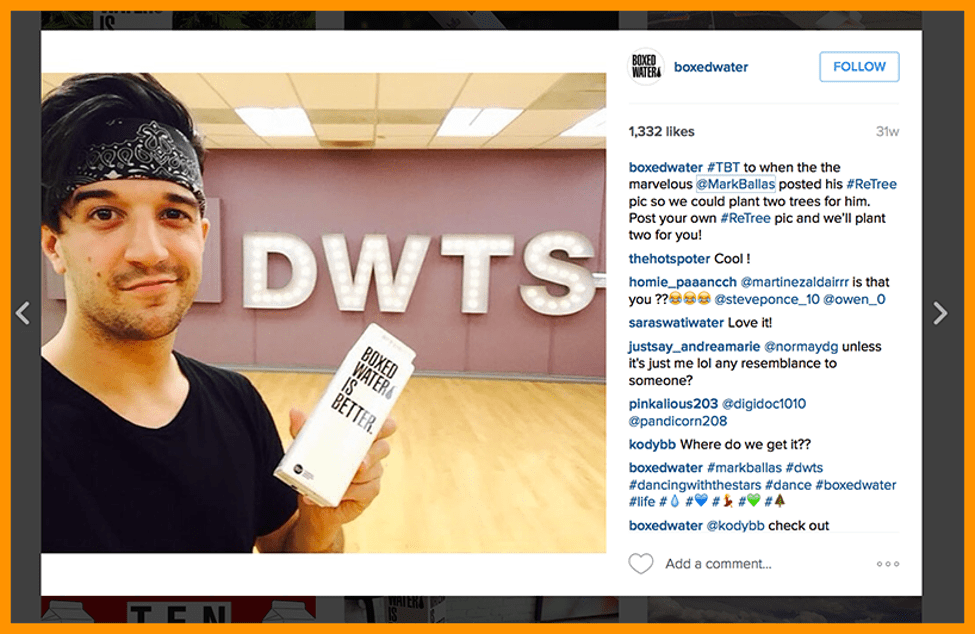
Subaru worked with 20 influencers to increase its sales in a campaign called Meet an Owner. The influencers used Subaru in their social media images and videos to boost brand awareness. The campaign resulted in an increase of 10% in sales. Here is an example of a post by Zach King that received over 9 million views:
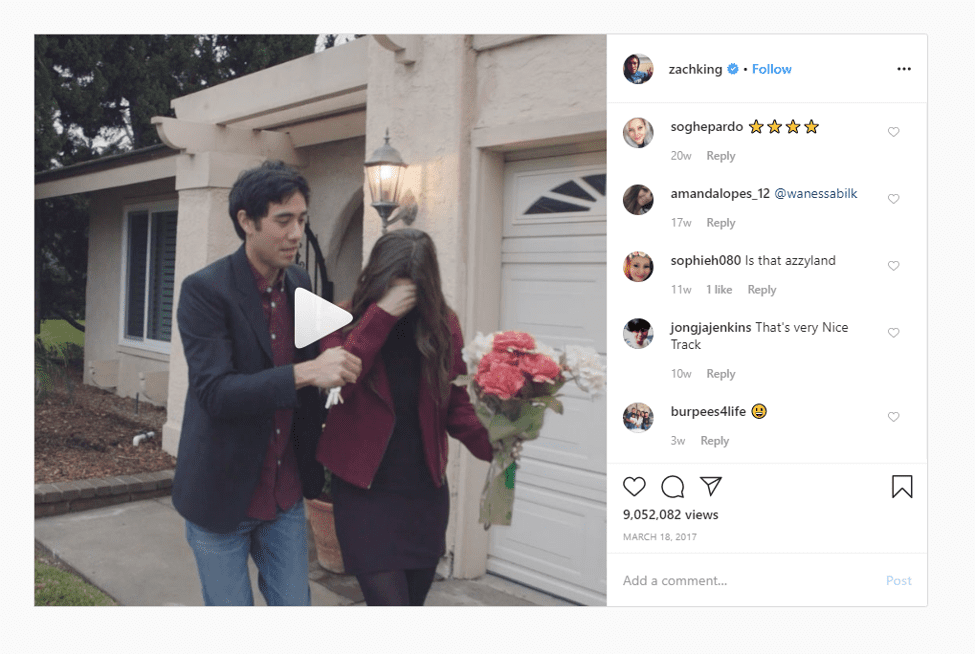
Influencer testimonials work great as long as you work with the right influencers. The right influencer with the right customer testimonial is one who has a significant impact on your primary target audience.
Your target audience should be the follower of the influencer you are working with. Else, your influencer will be an unknown personality for your audience, and it won’t work at all.
4. Success Story Testimonials
Nothing beats customer success stories and they are the perfect examples of testimonials in advertising. They provide readers with the complete story of how the product helped the users and are truly inspiring.
Here is an example of a perfect success story from Sumaya Kazi. She lost 50 pounds with intermittent fasting and her guide has passed 1,700K+ views. People are in love with her success story because it is inspirational and motivational. You can find a lot more testimonial examples of this type of social proofing.
Creating a Story from a Customer Testimonial Is Pretty Easy
The success story could be in the form of text, videos, case studies, interview testimonials, or a combination of all. However, the focus of the success story is on the ‘success’ that the customer achieved with your product. It should be inspirational for the readers.
There are several variables that should be considered when creating a success story for your testimonial page:
- It should explicitly discuss the success customer achieved with your product or service.
- It should compare before and after situation clearly. This helps readers relate to the story as they might be suffering from the same issue and they would be able to see themselves achieving success with your product.
- The success story must share and explain results preferably quantitatively. Quantifiable results are much easier to understand. In Sumaya Kazi’s example above, she explained that she lost 50 pounds instead of saying she lost weight.
- It has to be detailed. If it is short, it isn’t a success story rather a quote testimonial. They must explain all the aspects of success.
- It must be actionable. You need to show readers how they can achieve similar results. Clearly show how they can do the same.
Testimonial Propaganda
Next up, we'll define some concepts that you need to consider when adding any type of testimonials to your marketing.
Testimonials normally refer to having a real person recommend a product or service. Testimonial propaganda refers to having a famous person or figure (it can even be an animated character!) endorse and support a product or brand.
You can probably think of many such examples. For example, Pepsi is famous for using different celebrities in their huge ad campaigns. In 2017, they featured Kendal Jenner which didn't go that well.
When choosing the right famous person or influencer to endorse your brand, beware of transfer propaganda.
Transfer Propaganda
Transfer propaganda refers to the phenomenon, where the feelings towards the endorser are transferred directly onto the brand or product they are endorsing.
If you choose a controversial figure to use in advertising, it might create a lot of traffic, but it can also make some people automatically boycott your brand.
Bandwagon Propaganda
Bandwagon propaganda closely resembles fear of missing out and its principles.
However, bandwagon propaganda focuses strongly on the target audience's need to be included.
The aim of this type of propaganda is to get people to "hop on the bandwagon" by appealing to our deep-seated need of being a part of a group. It's a cognitive bias that explains the reasons behind viral trends.
For instance, seeing enough people using a certain product, will typically drive you into wanting one for yourself.
Examples of using the bandwagon propaganda in marketing include:
- Attaching coolness to a product or brand
- Be a part of the winning team (especially used in creating political campaigns)
- Limited time offer
- Creating limited edition collections or products
Conclusion
All of the discussed options are forms of social proof. There are several other great testimonial advertising examples that you can use in your advertising campaigns to boost them with additional social proof.
However, these 4 are the best ones that will give your brand a jumpstart. What type of testimonials will you use for your ads? What appeals to you the most? Are you ready to search for a suitable testimonial example?
Here are my two cents when it comes to creating a good testimonial...
Start off with video testimonials as it works best. Videos won’t disappoint you when it comes to creating effective testimonials for your target market. Don't delay using a great testimonial given from a customer's perspective as you'll be able to get an emotional response from website visitors based on your happy customer online review.
It just makes sense no matter how many employees your business has. In case you don't have any video reviews, try our video testimonial campaign to kickstart your video bank.
Btw, you can even collect and display employee testimonials to add more credibility to your business!
